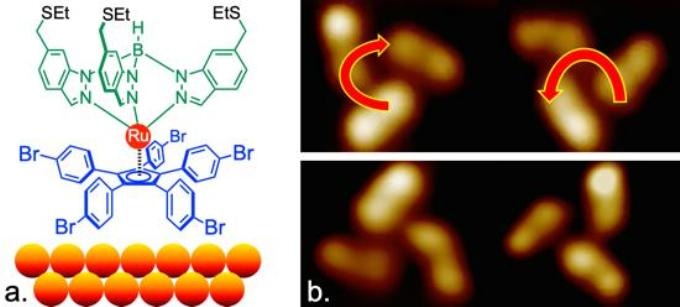Aug 27 2019
The year 2019 marks the 50th anniversary of the moon landing, and it could be said that the 20th century’s greatest science was all about big machines with the ability to voyage across the universe.
 (a) Chemical structure of the molecular gear; (b) STM image of the transfer of rotational motion from one gear to its neighbor. (Image credit: Gwénaël Rapenne, NAIST and UPS)
(a) Chemical structure of the molecular gear; (b) STM image of the transfer of rotational motion from one gear to its neighbor. (Image credit: Gwénaël Rapenne, NAIST and UPS)
The advancement of nanotechnology implies that the 21st century will be devoted to considerably smaller machines with the potential to move within the smallest spaces, such as human cells.
Scientists from Nara Institute of Science and Technology (NAIST), Japan, in collaboration with research groups from the University Paul Sabatier (France) and Prof. Saw-Wai Hla in Ohio University (USA), have described the latest nanomachine in Nature Communications. This nanomachine is a propeller that is capable of rotating at will in both clockwise and counterclockwise directions and transferring this motion to another molecule similar to gears.
Nature has been found to be superior at patterning similar machines by making use of molecules with the ability to transform electrical, chemical, or optical energy into interactions with the surface to produce motion.
For many nanomachines, we look at nature as our model. There are many examples of propellers with which organisms move in dynamic environments. Surprisingly, these natural nanomachines take the shape of large-scale propellers.
Gwénaël Rapenne, Professor, NAIST
Rapenne contributed to the new study. The propeller developed by Rapenne and his coworkers includes three components: three blades, each of which includes an indazole; a stator that includes five phenyl groups; and a ruthenium atom that adheres to the two and enables the rotation similar to a ball bearing.
One of the main differences is the conditions under which artificial nanopropellers operate. Natural nanomachines normally operate in environments comfortable for life; by contrast, artificial nanomachines can operate in considerably severe conditions.
Rapenne proves this by securing his machine to a gold surface and noting that some start to swirl at very cold temperatures (close to −200 °C). However, no propellers move at a temperature of −275 °C, confirming their potential to transform thermal energy into movement.
The propellers also exhibited the potential to rotate in various directions in a controlled way, but they never switched directions. This was the outcome of the way the propeller was secured to the gold surface, which led to a slight tilt in the stator. The tilt’s direction governs the spin direction. This aspect is suggestive of macroscopic propellers seen in the real world.
The stator acts as a ratchet-shaped gear that imposes a unidirectional rotation.
Gwénaël Rapenne, Professor, NAIST
Rapenne has employed gold to demonstrate the potentials of his nanomachines even earlier. Two years ago, he and his colleagues held the world’s first nanocar competition that involved the use of gold tracks. Although he does not anticipate to follow that attempt with the first nano single propeller competition, he considers that the new machines will be of significant use in the nano-realm.
“Our propellers can displace nearby molecules, showing that they can be used to move molecular loads for faster transfer of energy or information,” he stated.